Exemple thème 1 : Passive acoustic monitoring of bedload discharge in large gravel bed rivers
Développement de la méthode hydrophone de mesure du transport de fond dans les rivières
Geay, T., P. Belleudy, C. Gervaise, H. Habersack, J. Aigner, A. Kreisler, H. Seitz, and J. B. Laronne (2017), Passive acoustic monitoring of bed load discharge in a large gravel bed river, J. Geophys. Res. Earth Surf., 122, doi:10.1002/2016JF004112.
Geay, T., Belleudy, P., Laronne, J. B., Camenen, B., and Gervaise, C. (2017) Spectral variations of underwater river sounds. Earth Surf. Process. Landforms, doi : 10.1002/esp.4208.
Petrut, T., T. Geay, C. Gervaise, P. Belleudy, and S. Zanker. “Passive Acoustic Measurement of Bedload Grain Size Distribution Using Self-Generated Noise.” Hydrology and Earth System Sciences 22, no. 1 (2018) : 767–787 https://doi.org/10.5194/hess-22-767-2018.
Umberto Eco (2000) - Baudolino - Engl. trad by Harcourt Inc.
Hydrophones are used for passive monitoring of bed material movement. Experiments were performed in small and large gravel bed rivers ; signal properties are compared with other measurements.
Four questions are addressed in using this surrogate method concerning its capability for the monitoring of bedload discharge :
- When ? Critical discharge ? Rhythms ?
- How much ? Solid discharge ?
- What ? Grain size ? Transport type ?
- Where ? Within the river, within the X-section ?
1. When ? Critical discharge ? Rhythms ?
Rhine River at Leimersheim (Germany)-in low flow conditions
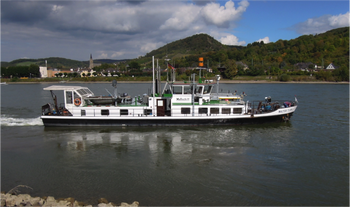
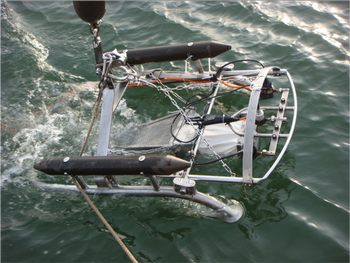
- The DfG sampler is dipped into the river from a bedload measuring boat.
- It is equipped with a video camera recording the image of the bed at the entrance to the sampler.
- A hydrophone records ambient noise.

conclusion 1 : - The hydrophone method is efficient for the detection of the beginning of transport
- It seems to be integrative of a large surface of bed (see point 4)
2. How much ? Solid discharge ?
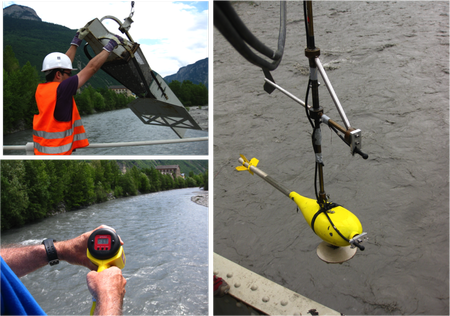
Arc River (Savoie, France) during flushing operations
Enjoy the music !
- The Helley-Smith sampler is dipped into the river from a crane.
- The surface velocity is measured with a radar (SVR Gun).
- At the same X-section, two hydrophones are immerged with a hydraulic bomb.

conclusion 2 :
In the present state of development, the method needs other measurements for comparison and calibration.
3. What ? Grain size ? Transport type ?
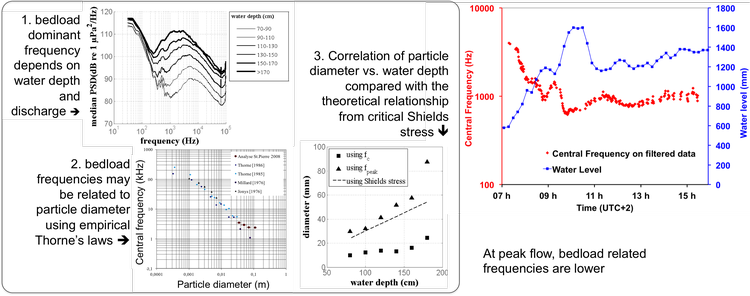
Arc River (Savoie, France)
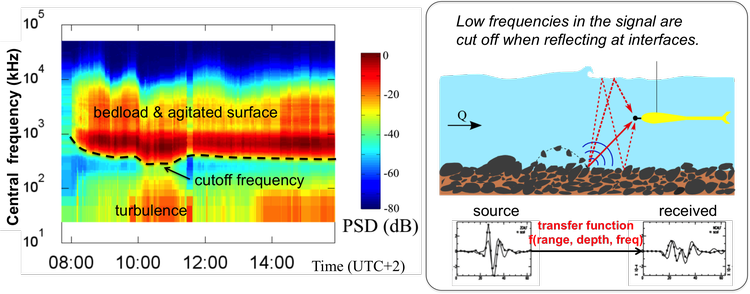
conclusion 3 :
Coarser particles are transported during peak flow
but complex sound propagation alters the signal.
4. Where ? Within the river, within the X-section ?
Drau River (Dellach, Austria) in spring and summer
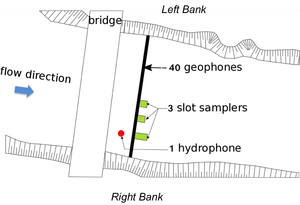
The hydrophone is fixed onto the river bed. It records sound from bedload during spring and summer.
The station is equipped with a series of 40 geophones and the correlation is made between the sound pressure level (hydrophone signal) and the energy recorded at each of individual geophone plates.


Period A : active bedload transport all across the section ;
Period B : active bedload transport in the left & center of the X-section. Correlations show that hydrophone integrates bedload signal at a distance of approx. 10m.
conclusion 4 :
Hydrophone is integrative of a large area of the river bed.
General conclusions
- The soundscape is a combination of different sources of noise and of propagation properties
- Adapted methods of signal analysis are required : e.g., time-frequency analysis, statistical analysis, correlation between several hydrophones
- This surrogate method requires calibration for quantitative estimation of bedload flux : compare with a “classical” measurement.
- Continuous / integrative / easy to deploy / cheap -> a good alternative especially for large rivers
- Operational for monitoring of bedload continuity through dams.
Contact :
Philippe Belleudy, IGE
Voir aussi :
Le chant des cailloux (épisode 1) : Nous avons oublié que la rivière est vivante.
Le chant des cailloux (épisode 2) : à l’écoute de la musique Rock’n Roll des Rolling Stones
 The federation
The federation Intranet
Intranet







